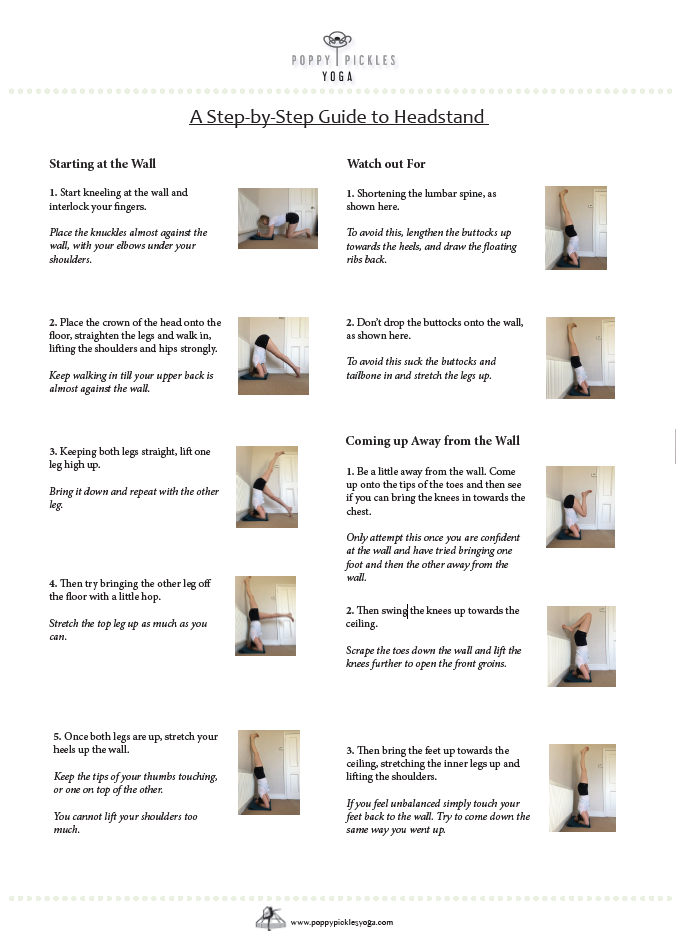Inversions are such an integral part of an Iyengar yoga practice. And by inversions I mean any pose in which your head is below your heart. The classic inversions are headstand and shoulderstand, and the energetic handstand and forearm balance. As well as this we have the gentler options of downward dog, standing forward fold (Uttanasana) and legs up the wall.
When would you NOT do inversions?
Inversions ARE good for you, but there are a few health conditions which mean that inversions should be avoided: unmedicated high blood pressure (although shoulderstand can be practised with caution), some heart conditions, neck injuries, recent stroke, detached retina, glaucoma, and epilepsy are common issues that should be addressed before inverting. Talk to your yoga teacher (or me) if you have any concerns.
Also, I would suggest that you take a break from inversions during your period. Generally in life we just have to ignore our body and get on with it, so it’s always nice to feel that we are being given the option of resting.
Why are inversions so good for you?
One of the (many) things that starts to decline as we get older is our awareness of our body in space or proprioception. This has a knock-on effect on our balance and stability. Going upside down is a proven way of improving our proprioception, making falls less likely.
Going upside down also helps improve the efficiency of the circulatory system, as it reverses blood flow and means that the heart doesn’t work as hard. It’s also very beneficial for the lymphatic system, which is a key part of our immune defence system.
Physically inversions are an excellent way to maintain core strength and flexibilty. In order to balance efficiently we need to be using the whole muscular system as well as strenthening the arms and shoulders (handstand, headstand and downward dog).
Also inversions are a great way of balancing out the endocrine system. Shoulderstand especially is great for perimenopause and menopause as it stimulates the thyroid and parathyroid glands which secrete hormones that regulate the metabolism.
Also, inversions are great for our mental health, giving us a new outlook on life and a confidence boost. According to BKS Iyengar in his book Light on Yoga, “Regular practice of Sirsasana [headstand] makes healthy pure blood flow through the brain cells. This rejuvenates them so that thinking power increases and thoughts become clearer.”
How to Practice them at Home
There are loads of ways to incorporate inversions into your home practice. It’s best to start with what you feel confident with, such as downward dog. Spend a bit of time in the pose, and make sure you relax the head and neck. Try different ways of practising, such as putting your hands on bricks, or pressing your heels to the wall. If you’re tired it’s a good idea to take support for your head. Your home practice is your way of finding out what works for you.
Shoulderstand is a great pose to practice at home, as we often don’t have time to fit it in during classes. Make sure you take support under your shoulders (as seen in the picture above) and if you can’t take your feet to the floor behind your head, then use a chair or go to the wall. Start by staying in the pose for a minute, and then build up from there. If you have any blood pressure issues always spend plenty of time in Halasana (plough pose) before going up into the pose, and come down slowly too.
In the Iyengar yoga system we don’t recommend that you practice headstand until you’ve been attending classes for a while. You should also be confident with your shoulderstand and all the standing poses (that doesn’t mean perfect). Once you’ve had a few goes at headstand in class it’s time to take your practice home as that’s where the real progress will happen. See below for a step-by-step guide to getting up into headstand at home.


